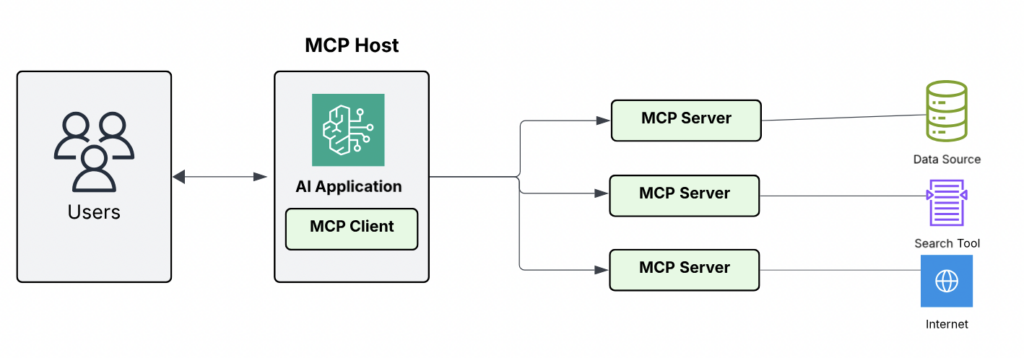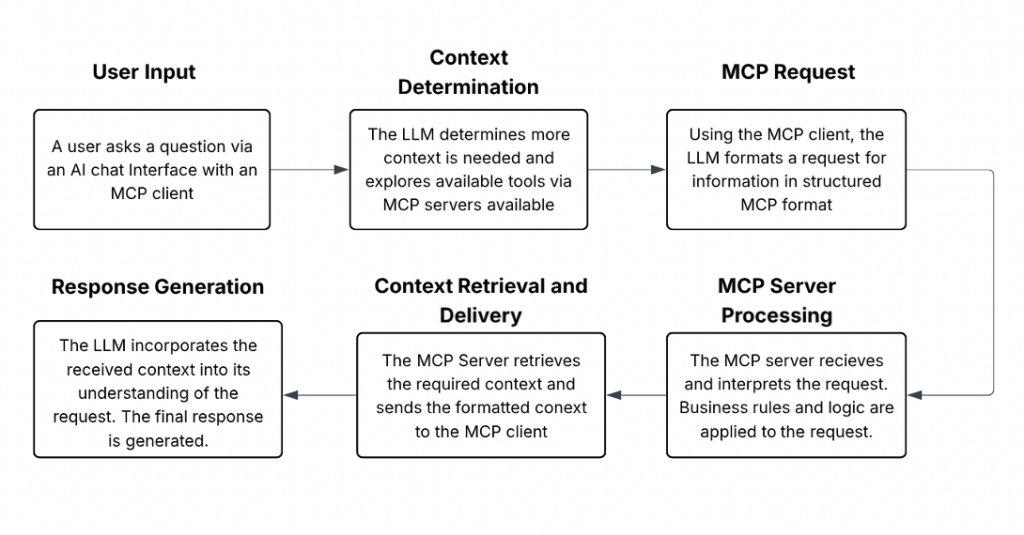
Andreea Stanovici, September 8, 2025
Get the Best Solution for
Your Business Today!
As artificial intelligence (AI) becomes an integral part of modern business solutions, there is a growing need for a streamlined way to connect AI agents with core operational systems to achieve strategic, measurable outcomes. To unlock the full potential of AI, it must operate in direct coordination with the systems that power daily operations such as inventory databases, CRM platforms, and supply chain systems. By embedding context-enriched AI within these core systems, businesses can enable smarter decision-making, greater efficiency, and reduce risk.
Table of Contents
What is Model Context Protocol (MCP)?
Model Context Protocol is an architectural design that bridges the gap between AI agents and business systems. Rather than building custom integrations for each system, MCP introduces a common communication protocol and a structured runtime interface that allows models to invoke business functions with context, validation, and traceability. Instead of reinventing integrations for every new AI tool or use case, organizations can scale AI adoption more efficiently by building a modular ecosystem of MCP servers that serve as reliable, controlled gateways to their operational data and systems.
How Does MCP Work?
MCP uses a client-server architecture to enable AI agents to interact reliably and securely with real world business systems. Each component has a defined role in maintaining structure, context, and control.

The MCP Host is the AI application that is using the agent such as a chat interface, an IDE, or a custom agent. The host orchestrates the interaction by initiating the request, managing permissions, and rendering responses.
The MCP client is a lightweight software module embedded in your AI application. It handles communication with external systems via MCP protocol, including discovering available tools, issuing requests, and processing responses. It gives the language model a structured way to reach beyond static data while ensuring every interaction is well defined. The MCP client communicates with remote services via HTTP with server-sent-events (SSE).
A MCP server exposes one system’s capabilities in a structured, model-readable way. When invoking a tool available to the AI, a JSON-RPC-formatted request will be generated containing an object with a property method identifying the parameters required to use the tool. An ID field is also commonly used to help the AI differentiate between requests and responses from various tools. Business rules are typically defined and applied at the MCP server level. This enables the AI to format an appropriate request for specific business functions.
Together, the MCP client and servers form a scalable middle layer between the AI and the operational systems it depends on. This setup keeps model interactions governed, enabling AI agents to request timely, accurate data while staying within organizational constraints. Let’s walk through the overall data flow and apply it to a supply chain use case to highlight the value of MCP.
Supply Chain Use Case

Step 1. The operations manager accesses the AI application from the organization’s business app to ask the question. “We received an order for 100 machines due next week. How many do we need to order and which vendor should we order them from?”
Step 2. The MCP client searches for available tools capable of providing the required context to answer the user’s question. Two MCP Servers have tools that would achieve this goal, the Inventory MCP and the Vendor MCP servers. The MCP client parses the query and routes 2 requests, one to the inventory MCP server and one to the Vendor MCP Server
Step 3. Inventory MCP Server Actions
- MCP Server validates permissions and request format
- Business rules are applied
- A minimum safety stock after fulfilling requests is applied
- All products associated in incoming purchase orders are excluded
- Products committed to current sales orders are excluded
- Inventory MCP Sever queries ERP system
Step 4. Vendor MCP Server Actions
- Validates request and authenticates with vendor systems
- Business rules are applied
- Filter vendors who can fulfill the reorder quantity within the delivery window
- Sorts filtered vendors by lowest total cost
- Queries multiple vendor APIs for available stock, pricing, and delivery lead times.
Step 5. The LLM interprets the context received from the MCP servers via the MCP client. It understands how many machines are currently in stock, and there are 2 vendors that can fulfill the order within the desired time frame at the desired cost. The LLM determines vendor B has a lower delivery lead time at the same price point as vendor A.
Step 6. AI Agent presents the recommendation to the user. “You need to reorder 50 machines to meet demand while maintaining safety stock. Vendor B offers the best price and can deliver within the required time frame.”
Depending on business policy and risk tolerance, another MCP server can also be engaged to directly place the order with appropriate permissions. By leveraging the MCP architecture, the operations manager can query current inventory, real-time vendor stock, and they can place the order directly all within 2 interactions.
Final Thoughts
Model Context Protocol unlocks a new level of AI integration for enterprises by transforming AI from a standalone tool into a dynamic, powerful, trusted partner that seamlessly interacts with core business systems. For organizations looking to boost efficiency and innovation, MCP is a foundational piece of the AI transformation journey.
Next Steps
If you’re ready to explore how MCP can transform your business, we’re here to help! We provide personalized guidance and practical solutions to make your AI journey smoother and more impactful.
To stay ahead with the latest updates and best practices, be sure to subscribe to our newsletter for expert insights delivered directly to your inbox.








